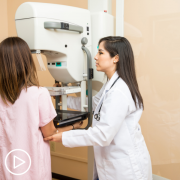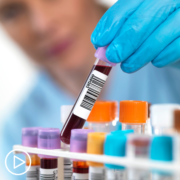Tag Archive for: HER 2
Key Questions Patients Should Ask Before Participating in a Breast Cancer Clinical Trial
Key Questions Patients Should Ask Before Participating in a Breast Cancer Clinical Trial from Patient Empowerment Network on Vimeo.
What questions should breast cancer patients ask their healthcare team before entering a clinical trial? Dr. Adrienne Waks shares her advice and key questions that breast cancer patients should ask before participating in a trial.
Dr. Adrienne Waks is the Associate Director of Clinical Research at Dana-Farber Cancer Institute. To learn more about Dr. Waks click, here.
See More from Breast Cancer Clinical Trials 201
Related Resources:

|

|

|
Transcript:
Katherine:
What are some key questions patients should ask their healthcare team about participating in a trial?
Dr. Waks:
Yeah, I think there’s a couple of major ones. What’s the rationale behind this trial? Why do you think it might be better than the standard? What do I stand to gain in terms of effectiveness? Do you think it could be worse than the standard of care, and why or why not? So, basically, trying to capture well, what’s the rationale and the potential benefit of a trial? We’re always doing trials to try to give the patient some sort of benefits, so very reasonable to ask about that. Number two, of course, is what are the extra side effects that could be associated with participation on this trial, and how much do you know about them?
Is this a drug that you’ve used for five years in a different context or is it a pretty new drug and you don’t have a great sense, so number two, what are the side effects potentially associated with participation on the clinical trial? And then the third thing I would say is what is the extra burden on me going to be, not in terms of side effects but in terms of life disruption, time spent and things like that? What are those extra burdens going to be if I participate in a clinical trial will I have to get extra scans, will I have to do extra visits, will I have to get extra biopsies?
You know, there are a number of clinical trials that require biopsies or have optional biopsies at least because in addition to studying a new drug we’re trying to understand in whom does it work and in whom does it not. And so, we want to have biopsies to help us understand that, but a patient should obviously want to be informed about those biopsies.
So, what will the extra on me look like? And then, we always try as investigators in a clinical trial to put in place as best we can some ways to sort of mitigate the burden on patients. Like, well if I have to have a biopsy, can my parking be covered that extra day or what accommodations can be made to try to mitigate some of the disruption or the extra time? So, I would say those are sort of the three or four main things to ask about.
Should Breast Cancer Patients Consider a Clinical Trial?
Should Breast Cancer Patients Consider a Clinical Trial? from Patient Empowerment Network on Vimeo.
Dr. Adrienne Waks, a breast cancer expert, discusses why and when patients should consider participating in a clinical trial.
Dr. Adrienne Waks is the Associate Director of Clinical Research at Dana-Farber Cancer Institute. To learn more about Dr. Waks click, here.
See More from Breast Cancer Clinical Trials 201
Related Resources:

|

|

|
Transcript:
Katherine:
Why should a breast cancer patient consider participating in a clinical trial?
Dr. Waks:
It’s a great question. I always tell patients and, of course, I work at Dana Farber, so we participate and I come to this question with a bias and a huge enormous amount of belief in the importance and the value of clinical research, but I honestly would encourage all patients to encourage clinical trials at all points in their breast cancer care. I think that often patients think that clinical trials are something that your doctor will bring up when you’re scraping the bottom of the barrel in terms of cancer treatment options.
You know, you’ve exhausted everything that’s good and now we’re going to give you treatments that were given to the mice last week or something like that. But that could not be further from the truth. At every stage of breast cancer treatment whether you have a stage I breast cancer or you have a metastatic breast cancer, all of the current standards for how we treat patients and all of the data that we have to tell us you should use those treatments because they’re beneficial, all of those standards and those data come from patients who came before you who participated in clinical trials. Those were not patients who were at the very last stage of their cancer treatment.
They were patients who could have been newly diagnosed with a Stage I breast cancer, newly diagnosed with metastatic breast or something like that. We change the standards of how we treat patients at all stages by running clinical trials.
In breast cancer, we have such effective treatments that it’s virtually unheard of that we would compare something to nothing. There’s almost never a time in breast cancer treatment when it’s ethical to offer nothing as a therapy, so most of our clinical trials are not saying you might get a placebo sugar pill and that’s it. It’s saying either you’ll get Arm A, which is this agent or you’ll get A plus B which is the standard plus something else. So, it’s not like by participating in a clinical trial you’re omitting standard therapy. What we’re generally trying to do is give you standard therapy and something better or replacing a part of standard therapy with something we think is going to do better.
Every time we design and implement a clinical trial, we’re obviously doing so because we hope that we can improve upon the current standard. So, there certainly isn’t a trial for everybody at every stage in their treatment course, and it’s absolutely fine if there’s no trial ongoing that’s the right fit for you, but I think it’s always a good question to ask. You know, is there a trial I should consider here?
Hesitant to Join a Breast Cancer Clinical Trial? What You Should Know.
Hesitant to Join a Breast Cancer Clinical Trial? What You Should Know. from Patient Empowerment Network on Vimeo.
What do breast cancer patients need to know about clinical trials? Breast cancer expert Dr. Adrienne Waks addresses common concerns and misconceptions about trial participation.
Dr. Adrienne Waks is the Associate Director of Clinical Research at Dana-Farber Cancer Institute. To learn more about Dr. Waks click, here.
See More from Breast Cancer Clinical Trials 201
Related Resources:

|

|

|
Transcript:
Katherine:
What would you say to patients who may be hesitant to participate in a trial?
Dr. Waks:
That’s a great question. I think many patients are at first hesitant to participate in a trial, which is natural. You know, there’s already so many overwhelming and scary decisions to be made when it comes to getting a breast cancer diagnosis or any cancer diagnosis that introduce a whole other set of discussions. Instead of variables, it’s found extremely overwhelming and adds another level of what might feel like uncertainty, so I think that’s a completely natural response is to be hesitant and overwhelmed if somebody brings up the clinical trial.
But what I would try to address in terms of patient concerns is number one, I think that patients worry that if they are approached about a clinical trial that means there aren’t other good options available to them which not always, but almost always is actually far from the truth. Usually it’s just because we have a standard, we think it’s pretty good but we’d like to do better than the standard and participating in a clinical trial is how we do that.
So, first I always, of course, assure patients this clinical trial is not like something we’ve never tested before and we know nothing about it, and it’s not because I don’t have other options for you. It’s just because I want to do better than the existing options and often it’s looking at an agent that’s already FDA-approved, but we’re trying to combine it with a different agent or something like that.
So, obviously, number one try to give patients some reassurance about what we already know about the trial agents and also reassure them about the fact that we don’t anticipate the efficacy of their treatment overall would be compromised. Rather we’re trying to improve upon that. So, I think that’s probably the most common concern that I hear from patients, but, of course, as providers it’s our job to understand from that specific patient who’s in front of you what are your particular concerns about clinical trials in general. And are those misconceptions that I can dispel for you, or are they real things that some women on trials do experience in which case we should talk through them and decide if it’s the right fit for you.
It’s almost always true that participating in a clinical trial does come with what I always call a few other hoops to jump through, because when you’re participating in a clinical trial we want to learn from your experience. So, we do want women to complete questionnaires about their side effects or have a second appointment one week later so that we can do an extra side effect check-in or something like that. You know, do an EKG that they wouldn’t otherwise need. So, there can be and often are some additional logistical or scheduling components that come with participation in the trial.
Again, we would want a patient to voice how that might or might not fit into her life and be very up front about what could be expected in terms of additional asks which can be extremely minimal or sometimes more disruptive depending on the trials. So, obviously, we just need to have a conversation about that.
What Are the Treatment Options for Early Stage Breast Cancer?
What Are the Treatment Options for Early Stage Breast Cancer? from Patient Empowerment Network on Vimeo.
Breast cancer expert Dr. Adrienne Waks reviews available treatment approaches for patients with early stage breast cancer and explains the role of sub types when choosing a treatment plan.
Dr. Adrienne Waks is the Associate Director of Clinical Research at Dana-Farber Cancer Institute. To learn more about Dr. Waks click, here.
See More from Thrive Breast Cancer
Related Resources:

|

|

|
Transcript:
Katherine:
Well, let’s get into the specific treatment options that are available for breast cancer patients. Could you tell us about those?
Dr. Waks:
So, fortunately, the answer to that question is enormous, because we have so many effective treatment options in breast cancer and generally our patients do very well in the long term when they are diagnosed with early stage breast cancer, so stage I or II or III breast cancer.
That might involve the breast, it might involve the lymph nodes under the arm, but it hasn’t traveled anywhere else in the body. So I’ll set aside metastatic breast cancer and just talk about stage I, II, and III.
So, as you may know, we think about as medical oncologists we completely separate treatment considerations for three different subtypes of breast cancer. Those are hormone receptor-positive, HER2-positive and then triple-negative. So, again, highlighting just important developments and not really the overall treatment planning for each of those subtypes, in ER-positive disease or estrogen receptor-positive disease hormonally-driven, estrogen-driven breast cancer – those are all sort of terms for the same thing, I think there have been a couple of important developments over the last few years.
Probably the most important recent one is the new understanding and demonstration that the CDK4/6 inhibitor abemaciclib, the brand name of that drug is Verzenio.
That drug when we administer it for two years after a patient has had their surgery and in conjunction with alongside the antiestrogen medicines; the antiestrogen medicines are usually done for a minimum of five years, when we add on to that the CDK4/6 inhibitor abemaciclib, we see that for women with higher risk disease, so maybe some lymph node involvement or a large tumor in the breast or both that the addition of the Verzenio, the abemaciclib seems to decrease their risk of recurrence of breast cancer a couple of years out. So, that’s been an important exciting development.
Again, not for all women within early stage estrogen-driven breast cancer, but for a little bit more advanced early stage disease like lymph node involvement. You know, we’re obviously always looking for ways to reduce that risk of recurrence for women who have a little bit more risk at diagnosis and the addition of abemaciclib was an exciting and welcome addition to our toolkit there.
In HER2-positive disease, which is about 20 percent of breast cancers overall, I think what the recent years have brought us is increasing understanding that in many cases we give women too much chemotherapy and that we need to be – so, here it’s less about adding on. Like the Verzenio example I was just talking about and more about individualizing and figuring out in whom and how we can pull back from sort of the kitchen sink approach that we take often to treating a HER2-positive early stage breast cancer and be more thoughtful and more personalized in the amount of treatment that we give women with HER2-positive breast cancer.
The reason for that is that we’re basically 20 years into understanding that for HER2-positive breast cancers we can treat those cancers very effectively with anti-HER2 antibody drugs like trastuzumab or Herceptin. We didn’t even know that until 20 years ago. And so, Herceptin, trastuzumab and similar drugs have really revolutionized how effectively we can treat women with HER2-positive breast cancers. And so, at this point, it’s becoming more and more clear that we can really lean more on our arsenal of anti-HER2 targeted therapies like Trastuzumab. Pertuzumab (Perjeta) is another one and trastuzumab MTNC and TDM1 is another one.
So, we have all these excellent smart targeted treatments for women with HER2-positive disease, but yet the standard of care is still to give all those good rational targeted treatments with a whole bunch of chemotherapy that comes with a lot of side effects.
I think more and more we’re figuring out that we can lean more on our anti-HER2 treatments and require less of the really side effect heavy chemotherapy, but how do we do that thoughtfully? We obviously don’t want to undertreat anybody, so how do we do that thoughtfully? How do we pick out the women who only need the anti-HER2 treatment and can get away with less chemotherapy. I think that’s really what’s exciting in HER2-positive early stage breast cancer right is how do we individualize and take advantage of targeted agents that we have?
And then finally, in the third subtype of breast cancer which is triple-negative breast cancer which accounts for about 10 percent of breast cancers, the most exciting development there clearly in the last year or so is the realization and the demonstration in randomized clinical trial that we can improve outcomes for those women if we give them not just chemotherapy but also chemotherapy combined with immunotherapy and specifically the immunotherapy agent called pembrolizumab or Keytruda.
So, up until a year or two ago, the standard for a stage I or II or III triple-negative breast cancer was to get a multiagent chemo regimen and chemo was really the only type of option we had to treat those triple-negative breast cancer patients and now we know from a major important clinical trial called Keynote 522, that if we take a standard chemo backbone and add Pembrolizumab immunotherapy onto it, that we can help those women do better in the long term. So, that’s really a pretty new in the last one or two years standard of care for triple-negative breast cancer.
And I guess the last thing I’ll say is not about one of those three subtypes of breast cancer but specifically for women with a BRCA1 or BRCA2 mutation associated with their breast cancer, which is a minority. It’s about 5 percent of breast cancer patients. Obviously, the proportion changes depending on your subtype of breast cancer and your age when you’re diagnosed, but for women who have a breast cancer associated with BRCA1 or 2 mutation and have a higher risk or early stage breast cancer.
So, again, they have a number of lymph nodes involved or a big tumor in the breast or something like that, we now know that we can add on one year of the PARP inhibitor medication called olaparib or Lynparza to the postoperative treatment of those breast cancer patients in addition to whatever other treatment they got; the antiestrogen pills, the chemotherapy, or a combination of those two, and with the addition of olaparib or Lynparza for a year that we can again see better long-term outcomes for those patients and help them avoid recurrences.
So, that’s not a majority of breast cancer patients but is a targeted treatment that we’re very excited about that definitely makes an important contribution to reducing risk for women with a BRCA1- or BRCA2-associated cancer or men for that matter. I’m saying women, but it could absolutely apply to men.
How Is Metastatic Breast Cancer Treated?
How Is Metastatic Breast Cancer Treated? from Patient Empowerment Network on Vimeo.
Breast cancer expert Dr. Adrienne Waks discusses treatment approaches for metastatic breast cancer and explains how research is evolving.
Dr. Adrienne Waks is the Associate Director of Clinical Research at Dana-Farber Cancer Institute. To learn more about Dr. Waks click, here.
See More from Thrive Breast Cancer
Related Resources:

|

|

|
Transcript:
Katherine:
What about people who have metastatic disease? What treatment advances are available for them?
Dr. Waks:
Yeah. You know, I think that’s an incredibly important question and a totally different set of discussions than we have with women with early stage breast cancer and unfortunately and unacceptably at this point for a woman diagnosed with metastatic breast cancer still typically that can become a life-threatening diagnosis.
So, it’s exceptionally important that we rapidly improve the treatment options that we have for women with metastatic breast cancer. Maybe everybody says this every year, but I think that this year, 2022, has been a particularly exciting year in terms of advances that we’re making in the treatment of metastatic breast cancer, really of all subtypes. I would say the most exciting class of drugs or type of drugs that’s coming out in breast cancer and in all malignancies honestly, is called antibody drug conjugates, which is to say an antibody. So, a molecule that’s targeted to some particular approaching on a cancer cell surface and then is attached to or conjugated to a chemotherapy molecule.
So, the antibody is like a smart delivery system directly to the cancer cell for what’s call a payload, basically like a sort of action molecule or the killer molecule, which is the chemotherapy.
Those kinds of antibody drug conjugants have made a huge impact in recent years in improving outcomes for women really with all subtypes of breast cancer, so that drug class I think is a very exciting one to watch in general. In terms of specific recent developments in metastatic breast cancer, so probably the biggest blockbuster development over the past year and really over just the past three months is the understanding that we can break out a subtype of metastatic breast cancer that we really didn’t even talk about before which is called HER2-low breast cancer. So, before if you asked me in May of 2022, there really were only two types of HER2 readouts for a breast cancer tumor.
There was a HER2-negative breast cancer tumor and there was a HER2-positive breast cancer tumor and as I already told you, the HER2-positive accounts for about 20 percent of breast cancers overall. The other 80 percent are HER2-negative. And so, historically, again you asked me three months ago I would have said if you’re HER2-positive and that 20 percent will give you these different HER2-directed treatments and if you’re not, we can’t use those. And what’s changed is that we’ve developed new antibody drug conjugants. So, drugs that are targeted against in this case the protein HER2 that seem to be so effective and work so well, that you don’t truly have to be HER2-positive.
You can be HER2-low and still benefit from these treatments, which is to say your cancer has a little bit of HER2 protein on the surface of the breast cancer cells but not a lot. So, not enough to make it positive but enough to make it low in its designation.
That’s actually a large proportion of breast cancer patients. It’s over 50 percent of breast cancer patients, so it’s significantly more than HER2-positive, so a large proportion of breast cancer patients actually fit into this new category called HER2-low and we now know from data that were presented in June of 2022 and then published in the New England Journal of Medicine, which is our biggest most high profile academic medical journal, we know that for patients who fall into that HER2-low category, again that’s more than 50 percent of breast cancer patients, that they can, if they have a metastatic breast cancer, benefit from this new antibody drug conjugate called trastuzumab deruxtecan (Enhertu).
When it was compared to the existing chemo options we have for those patients which do have some efficacy but nonetheless, when trastuzumab deruxtecan was compared to the existing chemo options, it clearly looked better for patients with HER2-low breast cancer. So, that was not just an exciting advance in terms of new treatment options which we always love to be able to offer to patients but also in terms of breaking out this entirely new designation and subcategory that captures more than half of our metastatic breast cancer patients and helping us to offer them something new and hopefully will be a pathway for other drugs to be developed in this space and for this new subcategory.
So, that was very exciting. I’ve been talking about it with patients all the time in the past just three months since those data came out.
You know, a second antibody drug conjugate that has also been very exciting in recent months and recent years is called sacituzumab govitecan which Trodelvy is the brand name of that one. That’s an antibody drug conjugate that’s targeted against a different protein on the cell surface that’s targeted against the protein Trop-2, so that’s where the Trodelvy comes from. It’s targeting Trop-2. That’s an antibody drug conjugate that we’ve known for probably three or more years now can be very effective in triple-negative metastatic breast cancer. So, we’ve had that option for a number of years in metastatic triple-negative breast cancer.
But again, just in the past few months have gotten good and exciting data that this Trodelvy or sacituzumab drug also works in estrogen-driven breast cancers.
And so, it’s giving another option to patients with not just triple-negative but also estrogen-driven breast cancer. So, that was another very recent development just in the last three months or so.
Katherine:
That’s really exciting.
What Do You Need to Know About Metastatic Breast Cancer Genetic Testing?
What Do You Need to Know About Metastatic Breast Cancer Genetic Testing? from Patient Empowerment Network on Vimeo.
Why is it important to ask about metastatic breast cancer genetic testing? Find out how test results could reveal more about YOUR breast cancer and could help determine the most effective treatment approach.
See More From INSIST! Metastatic Breast Cancer
Related Resources:
Transcript:
Why should you ask your doctor about metastatic breast cancer genetic testing?
The National Comprehensive Cancer Network – also known as the NCCN – recommends that every metastatic breast cancer patient undergo genetic testing. The test results can help predict how your cancer may behave and could indicate that one type of treatment is more effective than another.
This testing identifies specific gene mutations, proteins, chromosomal abnormalities, and/or other molecular changes that are unique to YOU and YOUR breast cancer.
There are two main types of genetic tests used in breast cancer:
- Germline or hereditary genetic testing, which identifies inherited gene mutations in the body. These mutations are present from birth, can be shared among family members and be passed on to subsequent generations.
- The second is somatic or tumor genetic testing, which identifies markers that are unique to the cancer itself. It is also commonly referred to as genomic testing, biomarker testing, or molecular profiling. Somatic mutations are NOT inherited or passed down from family member to family member.
- Depending on your history, your doctor may order one–or both–of these types of tests.
So why do the test results matter?
- If you have specific gene mutations – such as the BRCA1 or BRCA2 inherited gene mutations – it could indicate that a targeted treatment approach may be the most effective option. For example, there are two oral targeted therapies that are approved specifically for use in metastatic patients with BRCA1-positive or BRCA2-positive breast cancer.
- Results of these tests may also help you to find a clinical trial that may be appropriate for your particular cancer.
- Additionally, results from germline genetic testing may suggest that close family members should also be tested to determine their risk.
How can you insist on the best breast cancer care?
- First, always speak up and ask questions. Remember, you have a voice in YOUR breast cancer care.
- Ask your doctor if you have had–or will receive–genetic testing, including germline and somatic testing.
- If you have already undergone genetic testing, bring a copy of your results to your current doctor, so they can understand your results and determine whether additional testing is needed.
- Have a discussion with your healthcare team about the test results – including which markers were detected and how results may impact your care and treatment plan.
- Ask whether your family members should meet with a genetic counselor or undergo testing to help gauge their risk of developing breast cancer.
- And, finally, bring a friend or a loved one to your appointments to help you process and recall information.
To learn more about breast cancer and to access tools for self-advocacy, visit powerfulpatients.org/breastcancer.
Which Metastatic Breast Cancer Treatment Is Right for You? What You Need to Know
Which Metastatic Breast Cancer Treatment Is Right for You? What You Need to Know from Patient Empowerment Network on Vimeo.
What do you need to know before deciding which treatment is best for YOUR metastatic breast cancer? Expert Dr. Jane Meisel reviews recent research news, discusses the role of key tests–including biomarker testing –in determining a treatment plan, and shares advice for self-advocacy.
Jane Lowe Meisel, MD is an Associate Professor of Hematology and Medical Oncology at Winship Cancer Institute at Emory University. Learn more about Dr. Meisel, here.
[Editor’s Note: On August 23, 2021, the U.S. Food and Drug Administration (FDA) approved the Pfizer-BioNTech COVID-19 Vaccine for individuals 16 years of age and older.]
See More From INSIST! Metastatic Breast Cancer
Related Resources:

|

|

Factors That Guide a Metastatic Breast Cancer Treatment Decision |
Transcript:
Katherine:
Hello and welcome. I’m Katherine Banwell, your host for today’s program. In today’s webinar, we’ll discuss how you can access the most personalized metastatic breast cancer therapy for your individual disease and why it’s vital to insist on key testing. Before we meet our guest, let’s review a few more important details. The reminder email you received about this program contains a link to program materials.
If you haven’t already, click that link to access information to follow along during the webinar. At the end of this program, you’ll receive a link to a program survey. Please take a moment to provide feedback about your experience today, in order to help plan future webinars. And finally, before we get into the discussion, please remember, this program is not a substitute for seeking medical advice. Please refer to your healthcare team – Please refer to your healthcare team about what might be best for you.
All right, let’s meet our guest today. Joining us is Dr. Jane Meisel. Dr. Meisel, welcome. Would you please introduce yourself?
Dr. Meisel:
Absolutely and thank you so much for having me. My name is Jane Meisel and I’m a medical oncologist at the Winship Cancer Institute at Emory University. I’ve been here for about six years and before that, I did my training in Boston and at Memorial Sloan-Kettering in New York. And I specialize in breast cancer and have had a lot of great opportunities to treat amazing patients and participate in a lot of research.
And I’m looking forward to having this discussion with you today.
Katherine:
Thank you for joining us, we really appreciate it. So, let’s start by discussing the latest developments in treatment and research updates. Are there recent developments you feel breast cancer patients should know about?
Dr. Meisel:
Absolutely and I think it’s really been such a remarkable time because even during COVID, a pandemic, where I think a lot of people worried that research efforts would shut down or stall. We’ve still seen the approval of a number of drugs in the past year that’ve really already markedly changed lives. And a lot of important findings that’ve come out of other trials that they have opportunity to do that as well.
I think some of the biggest information that was presented at our most recent large meeting, which was the American Society of Clinical Oncology, or ASCO National Meeting in 2021, were a few things that pertain to the metastatic breast cancer population. One was two studies, the PALOMA-3 Trial and the MONALEESA-3 Trial, which looked at a class of drugs called CDK4-6 inhibitors along with anti-estrogen pills in metastatic estrogen-positive breast cancer.
And really confirm for patients that not only do these drugs improve the amount of time that people can stay on treatment before their cancer progresses, but actually improve how long people live. Even when they’re used very, very early on in treatment, they impact survival down the line for many, many years. So, it really confirms for physicians like me that this class of drugs should be used as the standard of care and first line for patients with estrogen-positive stage IV breast cancer, and I think that’s important for patients to know. Along those lines, there a drug called sacituzumab govitecan, or Trodelvy, which is a much easier to say name.
Katherine:
Yes.
Dr. Meisel:
A new antibody drug conjugate in triple-negative metastatic breast cancer. And we’ve also seen, since this drug was approved last year, it has markedly changed the lives of many patients with triple-negative disease. And the study called the ascent trial, which is what led to that drug’s approval was studied further and some of these additional results presented at ASCO this year.
And found that this drug not only improves again, how long people get before they have to move on to another treatment, but actually improves how long people live as well, even when given later on in the course of therapy. So again, really encouraging use especially in triple-negative metastatic disease, which is hard to treat. And I think another study that’s really worth patients and doctors taking a hard look at, was actually a study that looked at patient outcomes and patient experience. This is a study that actually talked with metastatic patients and gathered their views on treatment related adverse effects.
Talked to patients about what adverse effects they were experiencing from drugs. How they managed those adverse effects. And found that most patients, over 90%, will be willing to talk about reducing the dose of drugs or changing dosing schedules, in order to improve quality of life. And I think that’s really important because a lot of times, the doses of drugs that get approved are the doses that are the highest doses that don’t cause extreme toxicity. But sometimes people can have effective, really good outcomes on lower doses and have much better quality of life.
And in metastatic breast cancer where really the goal often times is to help people live as long as they can, but also as importantly, as well as they can, be able to have those open-ended conversations between patients and doctors about what’s really impacting your quality of life now and how can we make that better is important. And this study I think really highlighted that both for patients and physicians, how important that back and forth is to having a successful outcome. Both in terms of how life is lived, but in terms of quality of that life.
Katherine:
Right. Right. How can patients stay up to date on developing research?
Dr. Meisel:
It’s so interesting because there is so much coming out and I think it can be hard to figure out what Phase I study that looks exciting is really going to become something, versus what really could be important in my treatment today. And what I always tell people is actually, the NCI website. So, the National Cancer Institute, has a phenomenal page looking at advances in breast cancer research. So, if you Google “NCI advances in breast cancer research,” there’s a great page that comes up. And it’s impressively up to date and I think very patient-friendly.
Breaks things down into early stage and metastatic and then in the metastatic section, talks about estrogen-positive, HER2-positive, triple-negative, which we can talk about more today but are the three big subtype of metastatic disease that dictate how we treat them. And then have links to all the different research updates and talk about what these drugs are, what the classes are and what the settings are in which they’re studied.
And so, I think that’s a really great first stop and then the links can take you to all different stuff that’s on the page that you might want to look into more in depth. And then also, the Breast Cancer Research Foundation, which is a phenomenal organization. They have a great website, too and if you click around on the website, you can see not only who they’ve donated money to that’s doing promising research, they also have podcasts, they have a blog with science and research news. I think that’s a really great site for patients to use to stay updated.
Katherine:
Let’s shift gears for a moment and talk about another time sensitive topic, COVID. Now that vaccines are available, are they safe and effective for breast cancer patients?
Dr. Meisel:
Yeah, I think the short answer to that is yes, absolutely. I’m encouraging all my patients, no matter what their treatment status is to go ahead and get vaccinated. And we are seeing now this third surge in COVID with cases rising all over the country, and really among unvaccinated populations. And with the delta variant being more transmissible, I think it’s all the more time, even if you haven’t considered vaccination up until now, to really go ahead and strongly consider getting a vaccine.
I think some of the hesitations that some of the people have talked to me about is that there were not a lot of active cancer patients, if any, included in the initial trials. And whereas that is true, it’s still the case that now, so many cancer patients have been vaccinated. We haven’t really heard about adverse effects in vaccination being something that’s higher in patients who have cancer who are on active treatment. I think the one challenge is, if you have a compromised immune system because of cancer treatment, there’s the possibility that you might not mount the same immune response to the vaccine as someone who doesn’t have cancer or isn’t getting active treatment.
So, while I would say yes, definitely get vaccinated, I would also at the same time encourage caution in saying, because you might not mount the same, 95 percent or whatever immune response, it may still be a good idea to wear a mask when you go to the grocery store, taking those precautions because no one really knows what’s coming and it’s better to be safe than sorry. But I think we will get a lot of information as the months go on about, do we need boosters? Who might need boosters more soon than others and some of that will get clarified for us, but my short answer would be yes, vaccines for all.
Katherine:
Excellent, that’s very helpful.
Dr. Meisel:
Thank you.
Katherine:
Since this webinar is focused on metastatic disease, would you define metastatic breast cancer for us?
Dr. Meisel:
Absolutely. And I think metastatic breast cancer is one of those terms that as doctors, we throw around a lot and often times don’t stop to check understanding as to what that means.
And what metastatic breast cancer is and means, is breast cancer that is spread outside of the breast and surrounding lymph nodes to another organ system. So, metastatic breast cancer, some of the most common places where it spreads are to the bone, to the skin, to the lungs, to the liver, to the brain. There are other places it can spread to. I’ve seen it on the ovaries, in the GI tract. But basically, when breast cancer spreads outside of the breast and surrounding lymph nodes to another organ system, that’s when we consider it metastatic.
Katherine:
How can a patient ensure they are getting an accurate diagnosis?
Dr. Meisel:
Another good question. And I think the most important thing when you’re considering whether or not you have a diagnosis of metastatic breast cancer is to get a biopsy of that metastatic site. So, you wouldn’t want to assume, just based on a CT scan that shows something in the bone that you have metastatic disease. Ideally, we would biopsy that spot or some spot that was indicative of metastatic disease to actually prove that there is metastatic cancer in that distant site.
Because sometimes it’s nothing. Sometimes you get scans and a little bone abnormality, maybe a scar from a prior fall. And then also, sometimes if it is metastatic, sometimes the breast cancer, the hormone receptor status, for example, can change from the primary site to the metastatic site. And that might impact treatment. So, it’s important to both get a metastatic biopsy to confirm diagnosis. And also, to understand what the treatment plan might be. And I think also for patients, just to make sure that you understand what your stage is, ask your doctor.
Say, what is my stage? Because sometimes doctors think people understand and they don’t actually, so checking that understanding is important. But if your doctor or provider is not actively checking your understanding, you can check it with them to make sure that if you are metastatic or have Stage IV disease, which is another way we define metastatic or talk about metastatic cancer, that you make sure you have the definition right.
Katherine:
Right, right. So, once someone has been diagnosed with metastatic disease, are there key tests that’re used to help understand how their disease may behave and progress?
Dr. Meisel:
Absolutely. So, I think the first thing as I said is that metastatic biopsy. Another thing that’s very important is understanding the hormone receptor status and the HER2 status of the breast cancer. And probably for a lot of you listening, if you have listened to metastatic breast cancer webinars before or maybe know someone or have had a diagnosis yourself, you’re well versed in this. But for some who may not be, I think a quick overview is maybe helpful. Breast cancer can be divided into three different subtypes. So, triple-negative, estrogen-positive or HER2-positive. And estrogen-positive breast cancer is the most common kind.
That tends to be driven by hormones and often treated with what we call, endocrine therapy. So, anti-estrogen pills, things like Tamoxifen or aromatase inhibitors are examples of that. And that’s one kind. And then there’s HER2-positive breast cancer, which is a type of breast cancer that over expresses a marker called HER2. And we now, since we know about that marker, have been able to develop a lot of different treatments that target HER2 selectively.
And can be used to treat that subtype. And then triple-negative is basically estrogen-negative, progesterone-negative and HER2-negative. And that type of breast cancer traditionally was treated essentially only with chemotherapy. But now we’ve had some breakthroughs, which we’ll talk about I think later in this program talking about immunotherapy and more targeted therapy for that. But those subtypes help determine how we treat patients. And it also can sometimes predict behavior.
I would say one of the other things that helps us predict behavior of metastatic disease is, if a patient had early-stage disease before, how quickly they developed metastatic disease. So, for example, someone who develops estrogen-positive metastatic breast cancer 12 years out from their original diagnosis is statistically more likely to have a slower progressing course of disease than someone who develops triple-negative metastatic disease very soon after their initial treatment. So, I would say that’s the primary thing we look at in terms of determining treatment plan and then predicting overall course.
Katherine:
Right. Well, let’s talk about treatment options for advanced disease.
Can you review the types of treatments available for metastatic breast cancer?
Dr. Meisel:
Absolutely. And what I’ll do is, I’ll give you a broad overview and then because there’s so much and this is such a rich environment, I mean, I give hour long lectures just about the treatment of metastatic triple-negative breast cancer to our fellows. So, there is so much meaty information here. But I’ll give an overview with some key buzzwords so then people can go look up things that matter more to them or interest them more. So, as I said, we start with thinking about, is this hormone receptor-positive or estrogen-positive breast cancer? Is this HER2-positive or is this triple-negative? And those factors really send us down different paths.
So, if someone is estrogen-positive, I had mentioned before the PALOMA and MONALEESA studies showing that CDK4-6 inhibitors, which is a class of drugs that the first one was approved in 2015 and then two others have been approved subsequently. So, relatively new drugs. But those drugs, which are pills, added to traditional anti-estrogen therapy which would be aromatase inhibitors or fulvestrant.
Are often great first-line options for these patients. And people can do well for years on just that alone, with estrogen-positive metastatic breast cancer. On average, about two years before people progress and need something new. And then after that, there are lots of trials ongoing looking at different ways in which an estrogen-positive breast cancer might progress on that regiment and how do we target that. So that there are multiple other anti-estrogen options down the line that people can use in estrogen-positive breast cancer before they need to even think about going on to something like chemotherapy.
So, really lots and lots of options for those patients, but probably starting with a CDK4-6 inhibitor plus anti-estrogen combination. And then in HER2-positive breast cancer, typically the first-line treatment would be what we call monoclonal antibodies directed at HER2. So, something like Herceptin and Perjeta, which you may have heard of. And often combined with chemotherapy. But again, this is one of those areas that is also very, I think the art of medicine is very important and patient dependent.
Some of these regiments depend a little bit on patient’s age and other medical problems and desires, whether to include chemotherapy along with that frontline anti-HER2 regimen. Or whether to think about something like anti-estrogen therapy if the patient is HER2-positive and estrogen-positive. And then there are a lot of other different things we’re also using in HER2-positive disease after patients progress on that initial therapy, so there are what we call, antibody drug conjugates, where a chemotherapy like drug is attached to an antibody that then brings the chemo to the HER2-positive cell and allows for chemotherapy penetration more directly.
And then a class of drugs called tyrosine kinase inhibitors, which are oral drugs that get directed at HER2. So, another really exciting area to treat and a place where we’ve seen so many advances. And then in triple-negative breast cancer, I’d mentioned that chemotherapy has really been the mainstay of treatment historically because there weren’t great targets. But recently we’ve seen that immunotherapy, along with chemotherapy drugs like Keytruda, which you may have heard of.
Or atezolizumab, which is Mesenteric, can be used along with chemo and patients that overexpress a molecule called, PDL1. And that can actually include not just how long patients spend on the first treatment, but how long they live. So, we’re seeing a lot of triple-negative patients being great candidates for immune-based regimen now. And then for patients who have inherited a BRCA gene mutation, which many of you may have heard of. That gene mutation can actually predispose a triple-negative patient to be more receptive to a class of drugs called PARP inhibitors.
So, drugs like olaparib (Lynparza) or talazoparib (Talzenna) are new drugs that’ve been approved in the last couple of years in triple-negative metastatic breast cancer for patients who carry a BRCA1 mutation or BRCA2 mutation. And then there are also antibody drug conjugates in triple-negative breast cancer as well. The Trodelvy that’s been approved and then of course others that are in clinical trials currently. So, as you can see, it’s complex. I mean, the treatment of metastatic breast cancer is complicated. And so, it’s important I think to really be able to have a dialogue with your provider about what they’re recommending for you and why.
And I think there are often lots of options. And so, as much as you can make your doctor aware of what matters to you in terms of what side effects are you most afraid of or would you like most to avoid, what dosing schedules would be idea for your schedule for the rest of your life. So that you can deal with taking kids to school or the job that you’re currently working on or whatever, I think helps your doctor help you come up with the right regiment for you.
Katherine:
Yeah. Yeah. So, what factors are considered when deciding on the best treatment approach for an individual patient?
Dr. Meisel:
So, I think certainly the tumor type that we were talking about. Is it estrogen-positive or HER2-negative or HER2-positive? I think response to past treatments, both in terms of if someone has had metastatic disease for a long time and has had a few treatments already, how long did they respond to those treatments and how completely did they respond to those treatments. Did they have stable disease for a while or did their cancer actively shrink?
And then I think other than that, it would be some of the things I touched on. Side effect profiles. Do patients have pre-existing neuropathy from other chemotherapy? If so, maybe you want to avoid a regiment that causes more neuropathy. Schedule. Some patients, it’s really important to be on a certain schedule, as opposed to a different schedule. I think whether there are clinical trials available instead of whatever the standard of care regiment would be is also important.
Because for some patients who are interested in pushing the envelope or who might be a great candidate for a particular trial, if there is one that they’re a candidate for that’s not horribly inconvenient from a logistics standpoint, then trials I think are also a great option to consider. So, I think from an effectiveness standpoint, you want to think about the tumor type response to past treatments. And then potentially, if the patient has had, what we call genomic profiling, where the tumor has been sent for basically genomic analysis, to see what genes might be mutated in the tumor that could potentially drive a response to a newer, different therapy.
All those things can be taken into account as we think about the cancer. But then there is the patient specific factors, and I think those would be mainly side effects, schedule, clinical trials and desire or not to pursue those. And then, just what the patient’s perspective is on the plan that you’re offering them.
Katherine:
What is biomarker testing and how do results impact treatment options?
Dr. Meisel:
Great question. So, I think people often confuse germline mutations and somatic mutations. So, I’ll talk about that a little bit as we talk ab out biomarkers. So, I think biomarkers in general are factors within the tumor that allow us to make treatment decisions. So, if a biomarker in the tumor can predict response to a certain type of treatment, we want to know what that biomarker is so we can better treat the patient and more elegantly design a regimen. So, for example, having an estrogen-positive tumor, estrogen positivity is a biomarker suggestive of response to anti-estrogen treatments, which is why we give anti-estrogen therapy to ER-positive breast cancers.
But more recently, we’ve been able to move a little bit beyond estrogen, HER2- and triple-negative as our subtypes and think a little bit more in some patients about more sophisticated biomarkers. And that’s where somatic mutation testing comes in. So, there are germline mutations, which are inherited mutations that’re present in every cell in your body. So, for example, if your mother was a BRCA mutation carrier and based that BRCA mutation down to you, you would have a germline BRCA mutation. So, your cancer would carry a BRCA mutation, but so would every other cell you have.
And that’s a biomarker. That would make you a candidate for something like a PARP inhibitor. But in cancers, which the genes in the cancer have gone awry by definition, there are often other biomarkers within that tumor that may make you a candidate for certain treatments. And so, those mutations that arise in the cancer itself are called, somatic mutations. Those are mutations in the tumor, can’t be passed down to your offspring or anything like that and were not inherited by your parents. But mutations that’ve accumulated over time as these cancer cells have gone awry.
And so, genomic testing, or biomarker testing can be done often on a metastatic specimen. So, to be specific about it, say you had a metastatic breast cancer to the liver. You could have a liver biopsy done and that tissue from the liver biopsy could be sent for genomic testing. There are a lot of companies that do this and there are also some larger cancer centers that actually do in house testing for genomics. So, this testing can be done and what it does then is, it helps you determine, do you have a biomarker that predisposes you to a certain treatment.
So, if that metastatic liver tissues, for example contained high levels of PBL1 expression for example and you were triple-negative, that would say to your doctor, “Ooh, this is a great candidate for immunotherapy along with chemotherapy.” Or if you’re estrogen-positive, for example, and your tumor contains a mutation in the gene called PIK3CA and that might make you a candidate for a drug called, alpelisib (Piqray). So, these mutations could often be paired to a drug or treatment options, or sometimes to a clinical trial to allow patients to come take advantage of more targeted therapies.
That sometimes, because they’re targeted, have fewer side effects than drugs that are a little more discriminate.
Katherine:
Marie sent in this question prior to the program. Are there some genetic tests that’re more accurate than others?
Dr. Meisel:
That’s a good question. I would say most genetic testing platforms have been heavily vetted and approved by national organizations and laboratories that’ve been tested multiple times before they’re allowed to be marketed. So, I wouldn’t say that one genetic testing program is necessarily better than another. I think that any of the commercially available platforms that’re used are probably pretty accurate.
Katherine:
Okay. How does symptom management play into the treatment decision?
Dr. Meisel:
I was just going to add one thing to that, if that’s okay. I was going to say that I think it’s important when you’re using genetic testing platforms though to know what you’re testing for. So, there are some platforms that will just test for say, the three most common mutations in BRCA1 and BRCA2 that Ashkenazi Jews have.
And so, if you get that testing back and you’re negative, you might think oh, I don’t have a mutation in those genes. Well, we know from that testing, just as an example, is that you don’t have a mutation in those three alleles of that gene. But if you haven’t had full gene sequencing, you could have a mutation somewhere else in that gene. So, I would say all genetic testing that’s commercially available is probably pretty accurate. But it is important when you get testing done to know what you’re testing for and what you’re not testing for so you can interpret your results accurately. And genetic counselors, as well as your doctors can help you do that.
Katherine:
Right, right. Okay, I’m going to ask the question, this question again. How does symptom management play into the treatment decision?
Dr. Meisel:
I think symptom management is huge, because like I said and I tell this to all my patients at the outset of treatment that most of the time, metastatic breast cancer becomes a chronic diagnosis for a patient. You’re dealing with it, essentially like a chronic illness for the rest of your life. And you’re on some form of treatment for the most part, for the foreseeable future.
And so, making sure quality of life is as good as it can be is critically important. And I think symptom management is a huge part of that and we know that if we can treat and manage symptoms well, people can live better and often live longer because then they can stay on treatment for more extensive periods of time comfortably. And so, I always encourage patients, don’t be a martyr.
Don’t think you have to just bounce in here and tell me everything’s okay if it’s not okay. If you’re having symptoms and side effects from treatment, or from the cancer, I want to know about them so that we can really aggressively manage those symptoms just like we’re aggressively managing the cancer. A lot of times oncologists can do that on their own. We are pretty well versed in managing a lot of symptoms and side effects.
But a lot of times also, there are teams of doctors either who do palliative care or here at Emory, we call it supportive oncology where they are specially trained in things like pain management and managing more common side effects like nausea, constipation, diarrhea, appetite suppression, that can go along with cancer and with treatment.
And then they often will co-manage patients with us as well, just to make sure there’s that really strong focus on maintaining as much of a low symptom burden as possible.
Katherine:
So, you mentioned earlier, clinical trials. When should patients consider participating in a trial?
Dr. Meisel:
I think it’s a great question and I think the answer is really, almost any time. There are trials in every setting. So, I think one of the common misconceptions about clinical trials is that you really only should be in a clinical trial, or your doctor might only mention a clinical trial if they don’t have other options for you or if you’re really in stage. And I think that perception is changing. But I think the reality is that there are clinical trials in every setting.
So, we have clinical trails looking at prevention of breast cancer. Clinical trials looking to optimize early-stage treatment of breast cancer. Clinical trials looking at secondary prevention, so once you’ve had breast cancer, how can we reduce your risk of recurrence. And then lots of clinical trials in the metastatic setting both for patients who are initially diagnosed with metastatic breast cancer.
And then in second, third, fourth line and even for patients who have had tons and tons of additional therapy that we’re looking at new drugs for. So, I think at almost any juncture where you’re making a treatment change, it’s probably appropriate to say, would there be a clinical trail that you can think of that would be good for me in this setting? And it may be that there’s a one that’s 12 hours away, and it’s not convenient for you or feasible.
And it may be that your doctor doesn’t necessarily know of one but then that prompts them to ask a colleague who may be more involved in clinical trial design and development. Or it may be that there is one, but you ultimately choose not to pursue it because you have a different option. But I think it’s always appropriate to ask, would there be a trail for me? Because if there is, then maybe that opens up an option you hadn’t thought about before.
Katherine:
Sure. For patients who aren’t familiar with the stages of clinical trials, would you give us a brief overview of the stages?
Dr. Meisel:
Yeah. Absolutely. So, in terms of clinical trials that’re being done in humans, we talk about Phase I, Phase II and Phase III typically. So, a Phase II clinical trial is typically an earlier stage trial.
Looking at either a drug that has not been tested in humans before or a drug that has not been tested in a particular combination in humans before. And so, those trials are done only in select institutions, usually academic institutions as opposed to private hospitals. And they often have what’s called a dose finding phase and then a dose escalation phase. So, the earliest part of those trials is actually looking at, what is the safest dose to give to patients?
So, they start the first patients at a low dose of the compound. And if those patients do well, the next patients that’re enrolled get enrolled at a slightly higher dose. And then up until they reach the highest dose they can find where people are tolerating it and doing reasonably well. And in those Phase I trials, doctors and investigators are also evaluating efficacy, is this drug working. But the primary goal of the early phase trial is actually to find the right dose to then study in larger groups. And so, if they find the right dose and there’s good biological rationale for the compound, then the trial would go on to a Phase II.
Which might be just what we call single arm Phase II study, where every patient is getting that experimental drug. And we monitor them to see, is the drug effective, or is it less effective than the standard of care? Or sometimes they’re what we call, randomized Phase II trials where patients are randomized to either get the experimental drug, or to get what the standard of care would be in that situation. I think a lot of people get afraid about the idea of a randomized trial because they’re afraid they’re going to be randomized to a placebo. And that is really not done in the metastatic setting, because it wouldn’t be ethical to give a patient with active cancer a placebo.
So, usually the randomization would be either to the study compound or to a standard of care drug. And then if things look good in a Phase II trial, then a Phase III study is done which is usually what the FDA requires to allow a drug to go on and be administered outside of a study for approval. And those Phase III trials tend to be larger studies that’re done in larger groups of patients with more statistical validity because of their size, to determine, is this drug really better than the standard.
Katherine:
Right. We have another question we received earlier, this one from Eileen. She asks, how will I know whether my treatment is working?
Dr. Meisel:
That’s a really good question. So, I think for patients who have symptoms from their cancer, they often will know the drug is working because their symptoms improve. Say if you have lung metastases and you are short of breath and your shortness of breath gets better. That’s a really good sign that the treatment is working. I would say that often what we are doing, and it depends a little bit on the regimen and what the patient is getting and how often they’re coming in.
But we’re checking labs as well and sometimes there are lab abnormalities when a patient is diagnosed with metastatic cancer that can then improve over time. So, for example, if someone has a heavy burden of bone involvement with breast cancer, there’s a lab value called the alkaline phosphatases that will often be elevated. If that starts elevated and comes down, that’s a really good sign. And some of their liver function tests that we check and if a patient has liver metastases, we often will see those come down if a patient is responding.
There are also, what we call tumor markers that we can check in patients with metastatic breast cancer. Those would be proteins in the blood basically that can be made by the breast cancer in abundance. And those are called CA27-29 and CA15-3. Some doctors check both of them. Some will just check one depending on which one their laboratory at their institution is running. But typically, I will check those at diagnosis of metastatic disease. And then if it’s elevated, I know it’s a good marker to follow for my patient. And then I’ll follow that monthly or every three weeks, depending on when the patient is coming in to see me.
And if I see that marker start to go down, it’s not an absolute, but it can be a good early indicator of improvement with the treatment. And then I think it varies a little bit from practice to practice and based on patient preference. But often there will be scans done when a patient is initially diagnosed to determine the extent of the disease. So, usually a CT scan of the chest and the abdomen and the pelvis or a PET scan, which some of you may have heard of. Either one of those is good.
And that can be done about every 12 weeks usually in the beginning, to make sure a patient is responding and once you feel confident that they are, those can be done sell frequently. So, I would say the scans and the lab work and then the patient’s overall condition are usually the way that we look to see, are we having a response or not.
Katherine:
We’ve talked about several key tests. Some patients may be confused about whether they’ve received these tests. So, what questions should they ask their physician to make sure they’re getting appropriate testing?
Dr. Meisel:
I think it’s probably useful because not everybody needs every test, and I think there are often things you hear about online or from friends or even in a webinar like this, and there may be a good reason why you haven’t had that particular test. So, I wouldn’t assume that if you haven’t had everything that we’ve talked about today even, that someone’s made a mistake or that you need that and aren’t getting it. But I would ask. I think it’s always helpful to know more, knowledge is power. And so, if you have never had a CT scan or a CA27-29 level or a genomic testing.
I think it’s not a bad thing if you’re curious about it, to just ask your treating team, “Hey, I heard about genomic testing, is there a reason I haven’t had that? Or have I had that?” Maybe you have, and they called it something else. I think it is complicated, but I think it helps to understand what you’ve had done and what you haven’t had done. And sometimes, asking about something like that may prompt the team to do things that my benefit you.
Katherine:
Before we wrap up, Dr. Meisel, how do you feel about the future of breast cancer research and what would you like patients to know?
Dr. Meisel:
Yeah, I think one of the most important things and I actually said this to a family this morning where a loved one had received a new diagnosis of metastatic breast cancer is that the field has evolved so much over the past five years. I think often when people get a diagnosis of metastatic breast cancer, it’s the most dreadful feeling they ever had. They remember that day for the rest of their lives. But we are seeing so many people do so well for so long now and tolerate treatments well because the treatments are better tolerated.
And there’s I think more attention being paid now to symptom management. That people really can do so much better than they’ve been doing. And I would say really, every year, even every six months, when I go to give a lecture on a topic in metastatic breast cancer, I can’t just give the same talk. I’m always having to update my slides because there’s so many new things coming out, so much new research on the table.
And we’re seeing so many new drug approvals now that we’re starting to unlock some of these new mutations and reasons for progression and understanding new drug classes. So, really think it is a bright time to be in breast cancer research, and there’s never been a better time to be a patient if you have to fall into that category.
Katherine:
It all sounds so promising, Dr. Meisel. Thank you so much for joining us today.
Dr. Meisel:
You’re so welcome. Thank you for having me.
Katherine:
And thank you to all of our partners. If you would like to watch this webinar again, there will be a replay available soon. You’ll receive an email when it’s ready. Also, don’t forget to take the survey immediately following this webinar. It will help us as we plan future programs.
To learn more about breast cancer and to access tools to help you become a proactive patient, visit PowerfulPatients.org. I’m Katherine Banwell, thanks for joining us.
Metastatic BC Research: How Can You Advocate for the Latest Treatment?
Metastatic BC Research: How Can You Advocate for the Latest Treatment? from Patient Empowerment Network on Vimeo.
What do metastatic breast cancer patients need to know about the latest research news? Dr. Megan Kruse shares highlights from the 2020 San Antonio Breast Cancer Symposium (SABCS), along with her advice for advocating for the right testing to help guide treatment options.
Dr. Megan Kruse is a Breast Medical Oncologist at the Cleveland Clinic. More about this expert here.
See More From INSIST! Metastatic Breast Cancer
Related Resources:

|

|

Factors That Guide a Metastatic Breast Cancer Treatment Decision |
Transcript:
Dr. Kruse:
At this year’s San Antonio Breast Cancer Symposium, there were a few interesting presentations about the treatment of first-line metastatic triple-negative breast cancer that I think patients should be aware of.
Two of the presentations centered around trials that were presented in the past. Those reporting, patients reported outcomes from the IMpassion 130 study, which looked at chemotherapy for metastatic triple-negative disease plus the immunotherapy atezolizumab. And then, there was also an update on the results from the KEYNOTE-355 study, which was a study again of chemotherapy for metastatic triple-negative patients in combination with pembrolizumab, a different immunotherapy. And both of these studies showed that there was benefit for women in certain sub-groups of triple-negative breast cancer when looking at addition of immunotherapy.
And so, what I’d like to draw patients’ attention to with these presentations is that you have to be aware of if you fall into one of these categories so you know if you’re a candidate for the particular type of immunotherapy that can be added to chemotherapy. There are two different ways to test for if a patient is a candidate for immunotherapy and they are both tests that can be done on biopsies of metastatic or cancer recurrent sites in the body.
They can also be sent off of original breast cancer tumors. And what we now know is that for patients who do not have markers that suggest immune activation or where the immune system would be responsive to immunotherapy the addition of that extra therapy really does not help to improve cancer control over chemotherapy alone. And I think that’s a really important topic because everyone is very interested in immunotherapy, but it does have side effects of its own and it can actually be lasting side effects in terms of inflammation in organs like the liver, the colon, and the lungs.
And then, the third presentation that I’d like to bring up is the IPATunity study, which looked at the addition of a targeted therapy called ipatasertib to, again, chemotherapy for the first treatment of metastatic triple-negative disease.
And so, this is getting into an area of targeted therapy for metastatic triple-negative disease. And again, only looks at patients that have a particular marker that suggests sensitivity to this drug. And those are certain genetic markers, predominately changes in a DNA marker called PIK3CA. In this study, we actually found that there was no benefit for the targeted therapy added to chemotherapy for patients that had that genetic mutation, which was different than what was seen in earlier studies of the same combination. So, I think there’s more work to be done and it’s probably too early to say that this targeted therapy will not be used in treatment of metastatic breast cancer.
But what all of these research studies show together is that metastatic triple-negative cancer is not really just one disease. It’s very clear that within that one name, there are multiple different patient types and tumor types that need to be cared for differently.
And so, again, I think the theme from these abstracts and these research presentations is that we have to look into the right therapy for the right patient at the right time, which largely involved DNA-based testing.
So, when patients are thinking about their treatment options and how to best help with their providers about what treatment options exist for them, I think it’s important to recognize the type of testing that may be advantageous in your cancer type.
And so, for all metastatic breast cancer patients, we really recommend that they’ve had genetic testing to look for DNA changes like BRCA mutations that will lead to treatment options. For metastatic triple-negative disease, it’s important to make sure that you’re providers are testing for PDL1, which would make you a candidate for immunotherapy. And then, the more we learn about clinical trials, the more we have options for patients that have had drug-based DNA or genome-based testing. So, that’s an important term for patients to become familiar with is genomic testing.
And I think when you bring that up with your providers, they’ll know what you’re talking about and they’ll know that what you’re potentially interested in is new targeted therapy for the cancer that may either come in combination with chemotherapy or as a standalone treatment option. If you don’t have those options that are available, and FDA approved basis for regular routine patient care, there is always the option of clinical trials.
And so, if that is something that you’re interested in, genomic testing will often open the way. So, I think as you’re writing notes when you’re talking to your providers, you might wanna jot down whether or not you’ve had genetic testing and whether or not you’ve had genomic testing in the past, as both of those things will help potentially address all of your treatment options.
I’ve very hopeful about the research that is going to lead to new developments for breast cancer treatment in the next few years.
I think what we’ve seen both at this San Antonio Breast Cancer Symposium as well as other conferences in the recent past has been a lot of focus on finding the right treatment for the right patient at the right time. And so, patients seem to be very interested in finding out this information. They often come to clinic armed with the most recent data, which allows their providers to have really informed discussions about what the best treatment might be. And to talk about if the new treatments are not great right now, what treatments might look like in the future.
I think the other thing that’s encouraging about the research that we’ve seen presented at this conference is that some of these trials are very, very large. For example, the RxPONDER trial was a trial of over 9,000 patients. And I really think that’s amazing to get that many patients interested in research that may not directly impact their patient care but will impact the care of others moving forward.
It’s just a sign that our breast cancer patients are empowered, and they want to make a difference in the scientific community as a whole.
Breast Cancer Research News: SABCS Conference Highlights
Breast Cancer Research News: SABCS Conference Highlights from Patient Empowerment Network on Vimeo.
Expert Dr. Megan Kruse shares highlights from the 2020 San Antonio Breast Cancer Symposium (SABCS). Dr. Kruse provides an overview of what this news means for early stage breast cancer patients, along with her optimism about the future of breast cancer research and treatment.
Dr. Megan Kruse is a Breast Medical Oncologist at the Cleveland Clinic. More about this expert here.
See More From The Pro-Active Breast Cancer Patient Toolkit
Related Resources:
Transcript:
Dr. Kruse:
The San Antonio Breast Cancer Symposium is a national meeting with international presence that combines all of the latest data from research on breast cancer topics. It involves clinical research, basic science research, a lot of patient, and patient advocate support.
And the idea here is to bring together all the different disciplines that are involved in breast cancer patient care and do the best information and knowledge sharing that we can each year.
This year’s San Antonio Breast Cancer Symposium brought us a lot of interesting research focusing on early-stage breast cancer patients. I think the most important presentations that were given had to do with the treatment of high-risk lymph node-positive hormone receptor-positive breast cancer patients. And these were really across three abstracts. The first abstract of interest was the Monarch E study, which looked at high-risk women with hormone receptor-positive HER2-negative breast cancer and optimizing their medical therapy.
So, these patients are typically treated with anti-estrogen therapy and the idea of the research that was presented was if the addition of a targeted medication called abemaciclib or Verzenio could help to improve outcomes for women in this population. And what the trial found was that for women who took their anti-estrogen therapy for the usual length of time but added the abemaciclib for the first two years of that anti-estrogen therapy that there is actually an improvement in cancer-free survival time or an improvement in cure rates. And this was important because these women may not benefit from chemotherapy, as we’ll talk about in another abstract.
An addition research presentation that was given that goes alongside of the monarch E study was that of the Penelope B study. And the Penelope B took a similar population to what was studied in Monarch E. So, again high-risk women with lymph node-positive, hormone receptor-positive, HER2-negative breast cancer; however, in Penelope B, all of these patients had received pre-surgery chemotherapy.
And in order to qualify for the trial, the patients had to have some cancer that remained in the breast or the lymph nodes that was taken out at the time of their surgery. So, these are patients clearly in which chemotherapy did not do the whole job in terms of getting rid of the cancer. And again, the idea here was to add a second targeted therapy to the endocrine therapy to see if that would improve cancer-free time for patients in this population. The difference in this study was that the partner targeted therapy that was used was a drug called palbociclib or Ibrance.
And the drug was actually only used for one year in combination with endocrine therapy rather than two years as was used in the Monarch E study with abemaciclib. Interestingly enough, the Penelope B study was a negative study, meaning that it did not improve the cancer-free survival time for women who took the endocrine therapy plus targeted therapy compared to women who took the endocrine therapy alone.
So, I think that these are two interesting studies that one should look at together. And clearly, may impact what we do for the treatment of high-risk hormone receptor-positive women moving forward. The third abstract that I’d like to touch on that I think was important for women with early-stage breast cancer is the RxPONDER study, also known as SWOG 1007. And this study again was looking at lymph node-positive, hormone receptor-positive HER2-negative breast cancer patients and seeing if the addition of chemotherapy helped to improve their cancer-free survival compared to anti-estrogen therapy alone.
And so, in this study, while the study population was all women with early-stage breast cancer, meeting the one to three lymph node-positive criteria, you really have to break the results down into the results for pre-menopausal women and the results for post-menopausal women.
Because overall the study really showed no significant benefit to chemotherapy on top of endocrine therapy for women in this population; however, we did see that there was a clear benefit for women who were pre-menopausal. So, the women who had no benefit from chemotherapy were largely those who were post-menopausal, while those who were pre-menopausal derived extra benefit from chemo on top of anti-estrogen therapy. And that benefit depended on what the Oncotype recurrent score was.
With women that had the lowest of the recurrent scores having a chemo benefit of about three percent going up to over five percent for women who had Oncotype recurrent scores in the mid-teens to 25 range. In both of these groups, women who had Oncotype scores of 26 or above would have chemotherapy as per our standard of care.
So, I think that this abstract is important because in the past women who had lymph node-positive breast cancer generally received chemotherapy no matter what. More recently we’ve understood that not all of these cancers are created equal and that some cancers may not actually have benefit from chemotherapy in terms of improving cure rate. So, this study is a big step forward to help individualize and specify the treatment for women with lymph node-positive, hormone receptor-positive, HER2-negative early breast cancer.
I’ve very hopeful about the research that is going to lead to new developments for breast cancer treatment in the next few years.
I think what we’ve seen both at this San Antonio Breast Cancer Symposium as well as other conferences in the recent past has been a lot of focus on finding the right treatment for the right patient at the right time. And so, patients seem to be very interested in finding out this information. They often come to clinic armed with the most recent data, which allows their providers to have really informed discussions about what the best treatment might be. And to talk about if the new treatments are not great right now, what treatments might look like in the future.
I think the other thing that’s encouraging about the research that we’ve seen presented at this conference is that some of these trials are very, very large. For example, the RxPONDER trial was a trial of over 9,000 patients. And I really think that’s amazing to get that many patients interested in research that may not directly impact their patient care but will impact the care of others moving forward.
It’s just a sign that our breast cancer patients are empowered, and they want to make a difference in the scientific community as a whole.
How Can You Advocate for the Best Breast Cancer Care?
How Can You Advocate for the Best Breast Cancer Care? from Patient Empowerment Network on Vimeo.
Breast cancer expert Dr. Julie Gralow explains how you can advocate for the best metastatic breast cancer care, through speaking up, utilizing care team members and taking key steps to achieving better care.
Dr. Julie Gralow is the Jill Bennett Endowed Professor of Breast Medical Oncology at the University of Washington, Fred Hutchinson Cancer Research Center, and the Seattle Cancer Care Alliance. More about this expert here.
See More From INSIST! Metastatic Breast Cancer
Related Resources:
Transcript:
Katherine:
For patients who may be hesitant to speak out for themselves and advocate for their own care and treatment, what advice do you have?
Dr. Gralow:
You have a whole team who’s behind you, and I’m the MD on the team, but I’ve got a nurse practitioner, and a nurse, and a scheduler, and a social worker, and a nutritionist, and a physical therapy team, and financial counselors. I’ve got a whole team who works with me. And so, a patient might be hesitant to speak up during the actual appointment with their physician. It’s a short amount of time. I would recommend come into it with written-down questions because things go fast. You don’t get a lot of time with your doctor.
Things go fast, but don’t come in with 25 questions, either. Pick your top few that you want to get taken care of this visit because if you come in with 25 or 30, you’re going to lose the answers to most of them. Maybe bring somebody with you who’s an advocate and a listener for you who could be taking notes, so you can process and you don’t have to write it down, or ask if you can record it. It’s really important if you’re newly diagnosed or maybe there’s a progression and you’re going on a new treatment. That’s okay too.
But, I would also say you have a whole team behind you, so sometimes, if you don’t have time or if you’re hesitant to speak up in your doctor’s visit, you can ask the nurse, or maybe you can ask the social worker for help, even. See if there’s support groups around.
Interestingly, we’ve got a peer-to-peer network where patients can request to talk to somebody else who’s matched to them by some tumor features, and their stage, and things like that. Maybe finding somebody else who’s gone through something similar, and somebody independent to talk to instead of relying on your family.
It can also be really helpful to talk to a therapist or a psychologist about your fears, and sometimes, you want to be strong for your family, strong for your children and all, but you need a safe space with somebody that you can just express your fears and your anger if that’s what’s going on, or your depression or anxiety to while you’re trying to hold a strong face for others in your family. So, I would encourage patients to look at who is the whole team and talk to the other members of the team as well, and sometimes, they can help advocate.
Also, find somebody who might be able to come to your appointments with you, somebody who will help you advocate or remind you – “Didn’t you want to ask this question?” – or be another set of ears that you can process it with afterwards.
Katherine:
Dr. Gralow, we’ve covered a lot of useful information today for patients. Thank you so much for joining us.
Dr. Gralow:
Thank you, Katherine.
Katherine:
And, thank you to all of our partners. To learn more about breast cancer and to access tools to help you become a proactive patient, visit powerfulpatients.org. I’m Katherine Banwell.
Metastatic Breast Cancer Treatment and Research News
Metastatic Breast Cancer Treatment and Research News from Patient Empowerment Network on Vimeo.
As metastatic breast cancer testing approaches continue to expand, new and promising treatments have emerged. Dr. Lisa Flaum shares information on recently approved treatment options and the role of genetic markers in accessing targeted therapy.
Dr. Lisa Flaum is a Medical Oncologist at the Robert H. Lurie Comprehensive Cancer Center of Northwestern University. Learn more here.
See More From The Pro-Active Breast Cancer Patient Toolkit
Related Resources:

|

Essential Testing Following a Metastatic Breast Cancer Diagnosis |

Metastatic Breast Cancer Treatment Decisions: Which Path is Best for You? |
Transcript:
Dr. Flaum:
There are a lot of new and promising treatments for metastatic breast cancer. So, the treatments in general and the novel treatments and studies really vary based on the subset of metastatic breast cancer. So, when we’re making our treatment decisions, a lot of it is defined by those markers. So, if someone has a tumor that is hormone receptor, estrogen and progesterone receptor positive, and HER2-negative, the mainstay of treatment is typically drugs that target estrogen and often partnering drugs that target estrogen with other more novel or newer treatments.
So, just in the last five plus years, there have been a number of new drugs and even new drug categories that we didn’t have previously. So, for that population of the estrogen receptor positive tumors, the biggest breakthrough over the last number of years has been a class of drugs called CDK4/6 inhibitors. So, that includes drugs like Ibrance, Kisqali, Verzenio. And they’ve emerged as a very important and effective and often a recommendation for our first-line treatment for these patients combined with anti-estrogen therapies that have vastly improved outcomes for patients. So, a much higher percentage of patients respond to these drugs, the duration of the responses has extended quite a bit. And importantly, patients tend to tolerate this drug class really, really well.
So, for many patients starting out with that diagnosis, this type of drug class is going to be part of the discussion. Even in the last year, another drug category has emerged with approval of a new drug called alpelisib, which is something called at PI3 kinase inhibitor. So, again, back to defining the options based on the molecular profile of the tumor. So, this newer oral drug also partnered with anti-estrogen therapy, has been an important breakthrough for the treatment of patients who harbor this specific molecular abnormality. So, important to define whether that’s an option by some of these molecular testing.
There’s also newer drugs and studies of newer drugs that affect the estrogen receptor in different ways than some of our traditional medications.
And this is an ongoing area of significant research. So, that’s the estrogen receptor positive tumors.
For patients who have HER2-positive tumors, these are tumors that tend to be more aggressive, that tend to require more aggressive upfront treatment, which usually involves drugs that specifically target HER2. So, again, defining what’s driving the tumor and hopefully having drugs available that can target that specific abnormality. So, HER2 targeted drugs have evolved quite a bit over the last couple of decades.
Initially, we just had a drug called Herceptin and then a drug called Perjeta or pertuzumab was developed. Then more recently a drug called Kadcyla. And then even in just the last six to 10 months, two new drugs that target that HER2 protein. One of them is called tucatinib, the other one is called Enhertu. They’re not necessarily appropriate for the first line of treatment, but really sort of expands our toolbox in terms of how we treat these types of tumors. And these are developments that have occurred, for one of the drugs, just in the last six months, and the other within the last year. So, a lot of progress.
And then for the third subset of tumors, which are the triple-negative tumors, those are the ones that do not over-express estrogen, do not have estrogen or progesterone receptors, and don’t overexpressed HER2. This has been historically an area of unmet need. So, tumors where we can’t use anti-estrogen therapies, we can’t use HER2 targeted drugs. And so, the main stay has always been chemotherapy. And even for this subset, we’ve had progress.
So, one of the drug classes that’s been approved in the last couple years for triple-negative breast cancers is immunotherapy. So, immunotherapy has gotten a lot of press. It’s been really breakthrough treatment for a lot of different cancers, has lagged behind to some degree in breast cancer, but has become now one of the early treatment options for people with metastatic disease, specifically those that harbor a molecular marker, an immune marker, something called PD-L1. So, another example of the tumor’s biology dictating potentially one of the treatment options.
There have been other drugs that have been approved for triple-negative breast cancers in women who have BRCA mutation, so who have germline genetic predisposition to breast cancer. And that opens another array of treatment tools that have been approved in the last few years. And then more recently, just over the last six months, another drug that’s been approved for triple-negative breast cancer, which is a drug called sacituzumab, again, not first treatment, but something that defines potentially future lines of treatment. So, big picture, there has been a lot of progress that increasingly alters our treatment tools for patients and allows us to have sequential treatments that can be effective if their given treatment is no longer effective.
Metastatic Breast Cancer Treatment Decisions: Which Path is Best for You?
Metastatic Breast Cancer Treatment Decisions: Which Path is Best for You? from Patient Empowerment Network on Vimeo.
For each metastatic breast cancer patient, there are several variables to consider to access the best treatment path. Dr. Lisa Flaum explains key factors to consider, and discusses how the risks and benefits are weighed when making treatment decisions for an individual patient.
Dr. Lisa Flaum is a Medical Oncologist at the Robert H. Lurie Comprehensive Cancer Center of Northwestern University. Learn more here.
See More From The Pro-Active Breast Cancer Patient Toolkit
Related Resources:
Transcript:
Dr. Flaum:
So, when we’re determining a treatment approach, there are a number of variables. So, to some degree, based on a patient’s individual characteristics, their age, their other health issues, may guide what treatments are available or indicated or even desirable from a patient’s standpoint. To some degree, the locations and extent of disease are important. So, if someone has cancer and that’s causing a particular symptom, with bony sites being a particular example, there may be a role for something targeted; Something like radiation, and in rare cases, surgery to target a specific symptomatic or worrisome spot of metastatic cancer.
In general, the mainstay of treatment for metastatic breast cancer is what we call systemic treatment or medical treatment, treatment that’s going to go everywhere and treat the cancer wherever it is. In some situations, we may be deciding between more or less aggressive treatment, and the locations and sites of disease may be important in determining that. If someone has extensive disease, for instance in a vital organ like the lung, the liver, the brain, we may start with something more versus less aggressive to try to get it better under control quickly. Whereas people with more limited metastatic disease may be able to start with something less aggressive.
And then beyond that, a lot of the decision-making is based on those molecular markers that I alluded to, which are defined by the hormone receptor status. So, whether the tumor expresses those estrogen and progesterone receptors, and whether the tumor over-expresses HER2. And then to a lesser degree, based on other markers that may be defined by additional tests.
So, every treatment discussion we have is a two-way street. So, our job is to present the data, present options, present recommendations. And often, we have an opinion on where we would fall and if there are a number of different options. But to me, it’s a collaborative discussion. And if there are options, it’s weighing what potential benefit do we get from a single option or from adding something to that particular option versus what are the downsides? And some of it is discussion about logistics. Do we do something IV versus oral? Is there a particular side effect that we’re hoping to avoid, such as hair loss? Which of course, we’re trying to avoid. Some treatments may have a higher likelihood of working, but a higher likelihood of causing hair loss. That may factor into our decision.
So, whether it’s the first decision point when we’re deciding on preliminary therapy or future decision points as we go through this journey, there is always a discussion about this is where we are, these are what our options are. Here’s how we’re going to weigh the pros and cons. And then it comes back to a collaborative decision about how we weigh the risks and rewards and where we’re going with an individual patient.
So, clinical trials are always part of at least the conversation, so they’re always a consideration at each step of our discussion. So, from a preliminary treatment standpoint, we’re always going to go through here are our standard options. Here’s, again, what we think is most appropriate. And if there’s a clinical trial that’s appropriate in that scenario, we’ll lay that out there as an option. So, a clinical trial is always worth discussing. It’s always worth asking that your doctor, “Is a clinical trial appropriate for me at this point?” But it’s not always the right recommendation.
So, there are a lot of scenarios, especially at the beginning of treatment for metastatic disease where we have so many options, and so many new and novel treatment options and drugs that have been approved fairly recently that have defined the standard of care, that the standard is going to be often what we recommend. And a clinical trial may be something that we would use if that treatment fails to work or at some future point down the line. And at other points in time, we have very good, appropriate clinical trials that could be indicated at any step along the way. So, it’s worth the discussion. Whether it’s the recommendation or not depends on the circumstances, it depends on the time. What we have today was very different than what we might’ve had available six months ago and six months from now. But clinical trials are out there, and if the location that a patient is going doesn’t have access to clinical trials, it’s always reasonable to ask too, “Should I be going somewhere else to see if a clinical trial is appropriate?”
Essential Testing Following A Metastatic Breast Cancer Diagnosis
Essential Testing Following a Metastatic Breast Cancer Diagnosis from Patient Empowerment Network on Vimeo.
Following a metastatic breast cancer diagnosis, what tests are essential? Dr. Lisa Flaum reviews the role of key tests, and the impact of molecular (genetic) test results on treatment decisions.
Dr. Lisa Flaum is a Medical Oncologist at the Robert H. Lurie Comprehensive Cancer Center of Northwestern University. Learn more here.
See More From INSIST! Metastatic Breast Cancer
Related Resources:

|

|

|
Transcript:
Dr. Flaum:
When someone has either a diagnosis or a suspected diagnosis of metastatic cancer, meaning a diagnosis of cancer that has spread somewhere outside of the breast. And the most important initial step is establishing a tissue diagnosis. So, we could have our suspicions based on imaging, based on symptoms, but the most important thing is to confirm it. And usually that confirmation involves some type of tissue biopsy. So, collecting cells, examining them under the microscope, making sure that the diagnosis in fact, is cancer. Making sure that the cancer has spread from the breast, which is something that is definable under the microscope for the most part. And then evaluating various molecular markers within the tumor itself that are critical to guiding treatment.
So, in addition to the tissue diagnosis, the other important first step is what we call cancer staging. So, establishing the extent of the tumor within the body, which typically involves some type of scans, which may be variable depending on the situation or depending on the physician often could be a CT scan and a bone scan, maybe a PET scan. There may be an MRI.
So, a number of different tests that help us establish where the tumor is at baseline, so we can better understand the anatomy, but also to follow down the road to establish whether any given treatment is working. There are also maybe discussions of other types of molecular testing beyond what we determined in terms of the traditional biologic markers. You might hear the terms next generation sequencing tests like Foundation, Guardant, Tempus, which better define the cancer’s biology, which increasingly is becoming useful in terms of targeting treatment to someone’s specific cancer.
So, the molecular tests are looking at a few different things. So, first and foremost from a breast cancer standpoint, the most important basic molecular markers are what we consider to be the four main receptors, which is the estrogen and progesterone receptor, which dictates whether a given tumor is driven by estrogen and importantly dictates whether anti-estrogen therapy is going to be an appropriate component of the treatment. The other basic marker is called HER2, which is a protein that’s over-expressed.
In about 20% of breast cancer patient cells, and it’s also very critical in terms of guiding treatment. For specific types of breast cancer, once we know those preliminary molecular markers, then there’s an array of other types of anomalies within the tumor itself that could help to guide specific treatment. So, a couple of examples, and I can talk about that when you talk about treatment. If someone has a genetic predisposition to breast cancer with a BRCA mutation, there’s a specific treatment that might be appropriate. More recently, there’s another abnormality that can be detected by these tests called a PI3-Kinase mutation that identifies a population of patients who could be appropriate for another type of targeted therapy. So, for an individual, knowing what their particular profile is, whether or not those treatments are going to be indicated right at the beginning of treatment or maybe something that we use down the road. Inevitably, they’re going to help us understand what our tools are when we’re helping to make those decisions.









